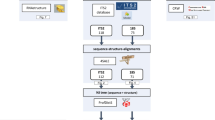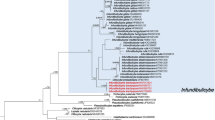Abstract
The second internal transcribed spacer (ITS2) of nuclear ribosomal DNA from 73 specimens of Astigmata was analyzed by PCR amplification and DNA sequencing. The length of the ITS2 region varied from 282 to 592 bp. The interspecific variation based on consensus sequences was more than 4.1%, while the intraspecific or intra-individual variation was from 0 to 5.7%. The variation between geographically separated populations (0–3.2%) was almost the same as the variation within strains. The sequences of the ITS2 region of Astigmata were concluded to be species-specific. The phylogenetic tree inferred from the ITS2 region supported Zachvatkin’s morphological classification in the subfamily Rhizoglyphinae. The species-specific ITS2 sequence is useful for the species identification of astigmatid mites and for studying low-level phylogenetic relationships.
Similar content being viewed by others
References
J. Felsenstein (1985) ArticleTitleConfidence limits on phylogenies: an approach using the bootstrap Evolution 39 783–791
J. Felsenstein (1995) PHYLIP (Phylogeny Inference Package) Version 3.57c Department of Genetics, University of Washington Seattle, USA
T. Gotoh J. Gutierrez M. Navajas (1998) ArticleTitleMolecular comparison of the sibling species Tetranychus pueraricola Ehara et Gotoh and T. urticae Koch (Acari: Tetranychidae) Entomol. Sci. 1 IssueID1 55–57
D.M. Hillis M.T. Dixon (1991) ArticleTitleRibosomal DNA: molecular evolution and phylogenetic inference Quart. Rev. Biol. 66 411–453 Occurrence Handle1:STN:280:By2C2M%2FmsFc%3D Occurrence Handle1784710
J.F. Honda Y. Nakashima T. Yanase T. Kawarabata Y. Hirose (1998) ArticleTitleUse of internal transcribed spacer (ITS-1) region to infer Orius (Hemiptera: Anthocoridae) species phylogeny Appl. Entomol. Zool. 33 IssueID4 567–571
W.R. Kuperus W. Chapco (1994) ArticleTitleUsefulness of internal transcribed spacer regions of ribosomal DNA in Melanopline (Orthoptera: Acrididae) systematics Ann. Entomol. Soc. Am. 87 IssueID6 751–754 Occurrence Handle1:CAS:528:DyaK2MXis1Whsr4%3D
Y. Kuwahara (1999) Chemical ecology of astigmatid mites T. Hidaka Y. Matsumoto K. Honda H. Honda S. Tatsuki (Eds) Environmental Entomology University of Tokyo Press Tokyo (in Japanese) 380–393
Y. Kuwahara S. Ishii H. Fukami (1975) ArticleTitleNeryl formate: alarm pheromone of the cheese miteTyrophagus putrescentiae (Schrank) (AcarinaAcaridae) Experientia 31 IssueID10 1115–1116 Occurrence Handle1:CAS:528:DyaE2MXlslGksLY%3D
Y. Kuwahara N. Mori K. Shimizu C. Tanaka M. Tsuda (1998) ArticleTitlePheromone studies on astigmatid mites: Recent progress – A comparison of molecular phylogeny, distribution and function of female sex pheromone in Caloglyphus spp. (Acarina: Acaridae) J. Asia-Pacific Entomol. 1 IssueID1 9–15 Occurrence Handle10.1016/S1226-8615(08)60002-3
Y. Kuwahara L.T. My-Yen Y. Tominaga K. Matsumoto Y. Wada (1982) ArticleTitle1,3,5,7-Tetramethyldecyl formateLardolure: aggregation pheromone of the acarid miteLardoglyphus konoi (Sasa et Asanuma) (Acarina: Acaridae) Agric. Biol. Chem. 46 IssueID9 2283–2291 Occurrence Handle1:CAS:528:DyaL38XlvFKjtLY%3D
Y. Kuwahara T. Satou T. Suzuki (1991) ArticleTitleChemical ecology on astigmatid mites. XXXI. Geranial as the alarm pheromone of Histiostoma laboratorium Hughes (Astigmata: Histiostomidae). Appl Entomol. Zool. 26 IssueID4 501–504 Occurrence Handle1:CAS:528:DyaK38Xht1GitLk%3D
W.S. Leal Y. Kuwahara T. Suzuki K. Kurosa (1989a) ArticleTitleβ-Acaridial, the sex pheromone of the acarid mite Caloglyphus polyphyllae. Pheromone study of acarid mites XXI Naturwissenschaften 76 332–333 Occurrence Handle10.1007/BF00368436 Occurrence Handle1:CAS:528:DyaL1MXltlWjt7g%3D
W.S. Leal Y. Kuwahara T. Suzuki H. Nakao (1989b) ArticleTitleChemical taxonomy of ecologically important Tyrophagus Mites (Acariformes, Acaridae). Agric Biol Chem. 53 IssueID12 3279–3284 Occurrence Handle1:CAS:528:DyaK3cXhtlKiu74%3D
J. Lohse H. Rinder R. Gothe M. Zahler (2002) ArticleTitleValidity of species status of the parasitic mite Otodectes cynotis Med. Vet. Ent. 16 133–138 Occurrence Handle10.1046/j.1365-2915.2002.00355.x Occurrence Handle1:STN:280:DC%2BD38zmtl2ksw%3D%3D
H. Nakao K. Kurosa (1988) ArticleTitleDescription of four species of acarid mites newly recorded from Japan, with reference to the damage caused to crops (Acari: Astigmata) Jpn. J. Appl. Ent. Zool. 32 135–142
M. Navajas J. Lagnel J. Gutierrez P. Boursot (1997) ArticleTitleSpecies-wide homogeneity of nuclear ribosomal ITS2 sequences in the spider mite Tetranychus urticae contrasts with extensive mitochondrial COI polymorphism Heredity 80 742–752
B.M. OConnor (1982) Acari: Astigmata S.P. Parker (Eds) Synopsis and Classification of Living Organisms, Vol. 2 McGrawHill New York 146–169
C.H. Porter F.H. Collins (1991) ArticleTitleSpecies-diagnostic differences in a ribosomal DNA internal transcribed spacer from the sibling species Anopheles freeborni Anopheles Hermsi (Diptera: Culicidae) Am. J. Trop. Med. Hyg. 45 IssueID2 271–279 Occurrence Handle1:CAS:528:DyaK38XhtlOi Occurrence Handle1877723
S.M. Rich B.M. Rosenthal S.R. Telford SuffixIII A. Spielman D.L. Hartl F.J. Ayala (1997) ArticleTitleHeterogeneity of the internal transcribed spacer (ITS-2) region within individual deer ticks Insect Mol. Biol. 6 IssueID2 123–129 Occurrence Handle1:CAS:528:DyaK2sXitF2rs7k%3D Occurrence Handle9099576
T. Sakata S. Shimano Y. Kuwahara (2003) ArticleTitleChemical ecology of oribatid mites III. Chemical composition of oil gland exudates from two oribatid mites, Trhypochthoniellus sp. and Trhypochthonius japonicus (Acari: Trhypochthoniidae) Exp. Appl. Acarol. 29 IssueID3–4 279–291 Occurrence Handle10.1023/A:1025882214375 Occurrence Handle1:CAS:528:DC%2BD3sXnsFagur4%3D Occurrence Handle14635814
M. Sasa (1965) Mites – An Introduction to Classification, Bionomics and Control of Acarina University of Tokyo Press Tokyo (In Japanese) 368–382
D.L. Swofford (2002) PAUP* 4.0 beta version: Phylogenetic Analysis and Using Parsimony (and Other Methods) Sinauer Associates Inc. Sunderland, Massachusetts, USA
J.D. Thompson D.J. Higgins T.J. Gibson (1994) ArticleTitleClustal W: Improving the sensitivity of progressive multiple sequence alignment through sequence weighting, positionspecific gap penalties and weightmatrix choice Nucleic Acids Res. 22 4673–4680 Occurrence Handle1:CAS:528:DyaK2MXitlSgu74%3D Occurrence Handle7984417
H. Wada N. Satoh (1994) ArticleTitleDetails of the evolutionary history from invertebrates to vertebrates, as deduced from the sequences of 18S rDNA Proc. Natl. Acad. Sci. USA 91 1801–1804 Occurrence Handle1:CAS:528:DyaK2cXjtF2lu7o%3D Occurrence Handle8127885
D.M. Wesson D.K. McLain J.H. Oliver J. Piesman F.H. Collins (1993) ArticleTitleInvestigation of the validity of species status of Ixodes dammini (Acari: Ixodidae) using rDNA Proc. Natl. Acad. Sci. USA 90 10221–10225 Occurrence Handle1:CAS:528:DyaK2cXntlyjtA%3D%3D Occurrence Handle8234280
D.M. Wesson C.H. Porter F.H. Collins (1992) ArticleTitleSequence and secondary structure comparisons of ITS rDNA in mosquitoes (Diptera: Culicidae) Mol. Phylogenet. Evol. 1 IssueID4 253–269 Occurrence Handle10.1016/1055-7903(92)90001-W Occurrence Handle1:CAS:528:DyaK3sXltlGqt7g%3D Occurrence Handle1364170
A.A. Zachvatkin (Eds) (1941) Tyroglyphoidea (Acari). Fauna of U. S. S. R. Arachnoidea. Vol. VI (1) Amer. Inst. Biol. Sci. Washington 1–573
M. Zahler A. Essig R. Gothe H. Rinder (1998) ArticleTitleGenetic evidence suggests that Psoroptes isolates of different phenotypes, hosts and geographic origins are conspecific Int. J. Parasitol. 28 1713–1719 Occurrence Handle10.1016/S0020-7519(98)00145-3 Occurrence Handle1:CAS:528:DyaK1cXnvVGju7g%3D Occurrence Handle9846608
M. Zahler A. Essig R. Gothe H. Rinder (1999) ArticleTitleMolecular analyses suggest monospecificity of the genus Sarcoptes (Acari: Sarcoptidae) Int. J. Parasitol. 29 759–766 Occurrence Handle10.1016/S0020-7519(99)00034-X Occurrence Handle1:CAS:528:DyaK1MXktlKntrs%3D Occurrence Handle10404272
Author information
Authors and Affiliations
Corresponding author
Additional information
Chemical Ecology of Astigmatid Mites LXXV
Rights and permissions
About this article
Cite this article
Noge, K., Mori, N., Tanaka, C. et al. Identification of astigmatid mites using the second internal transcribed spacer (ITS2) region and its application for phylogenetic study. Exp Appl Acarol 35, 29–46 (2005). https://doi.org/10.1007/s10493-004-1953-0
Received:
Accepted:
Issue Date:
DOI: https://doi.org/10.1007/s10493-004-1953-0




